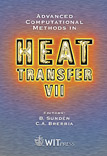Induced Heat Transfer From Human Skin; Its Relationship To The Blood Perfusion In The Tissue
Price
Free (open access)
Transaction
Volume
35
Pages
9
Published
2002
Size
411 kb
Paper DOI
10.2495/HT020481
Copyright
WIT Press
Author(s)
T S O'Donovan, M A Atmane & D B Murray
Abstract
The present research investigates the relationship between surface heat transfer from human skin and the physiological features of human tissue. The work is based on the assumption that changes in the tissue characteristics can be thermally sensed at the skin surface. For example, the presence of a malignant tumour in the tissue, known to be at a slightly different temperature than the surrounding tissue, is expected to have m effect on both temperature and heat flux at the skin surface. A numerical model, based on the bioheat equation proposed by Pennes [l], is developed. The bioheat equation represents energy conservation within the tissue and is solved using finite difference schemes. The configuration adopted consists of a region of human tissue and a surface thermal probe at which is imposed an external convective heat flux. The usefulness and the feasibility of this non-intrusive probe in monitoring the behaviour of the human thermal regulatory system are assessed. The input parameters of the model are the blood perfusion or volumetric flow rate within the tissue and the convective heat flux imposed at the probe. Results are monitored in the form of time varying heat flux and temperature at the skin surface and in the form of the temperature field within the tissue. It is shown that the time varying heat flux curve at the skin depends on the blood perfusion rate within the tissue. A similarity in the decay law of the heat flux and temperature at the skin is observed also. This introduces a redundancy and has as a consequence the possibility to access one of these quantities independently from the other. The existence of a tumour modifies, depending on its size and position with respect to the skin, the above-mentioned characteristics.
Keywords





